Why do some plants seem to have a certain magic about them, one that fills us with joy or evokes a sense of calm? For me, that plant is the Crepe Myrtle. The very sight of them never fails to make me smile and brighten my day. What is it about these trees that endears them to me so much? Let me share my reasons, hoping to convey why Crepe Myrtles hold such a cherished spot in my heart.
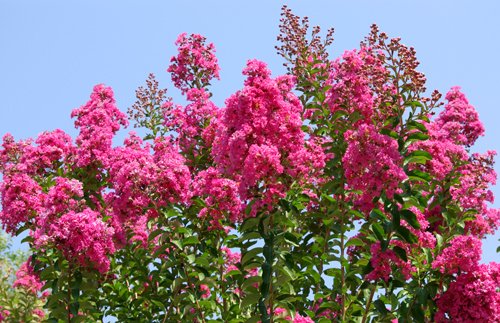
A Burst of Color All Summer Long
Crepe Myrtles are synonymous with vibrant summer days. They bloom in a riot of colors that can stop anyone in their tracks. Picture shades of pink, red, purple, and white dotting the landscape. For me, their blossoms symbolize joy and celebration. The way their petals flutter with the slightest breeze is almost like they’re putting on a show for anyone willing to watch.
Colors that Captivate
Each Crepe Myrtle variety has its unique charm. Some have blossoms in a solid, eye-catching hue, while others grace us with a more subdued, pastel palette. Take, for example, the ‘Dynamite’ variety with its bold red flowers or the ‘Natchez,’ which flaunts pristine white blooms. Looking at a Crepe Myrtle in full bloom feels like gazing into an artist’s palette with colors blending seamlessly into one another.
Seasonal Showstopper
Crepe Myrtles don’t just put on a summer show. Their beauty extends beyond the blossoms. As summer transitions to fall, their leaves turn brilliant shades of red, orange, and yellow. It’s like they know how to make an exit, leaving a lasting impression as they shed their leaves.
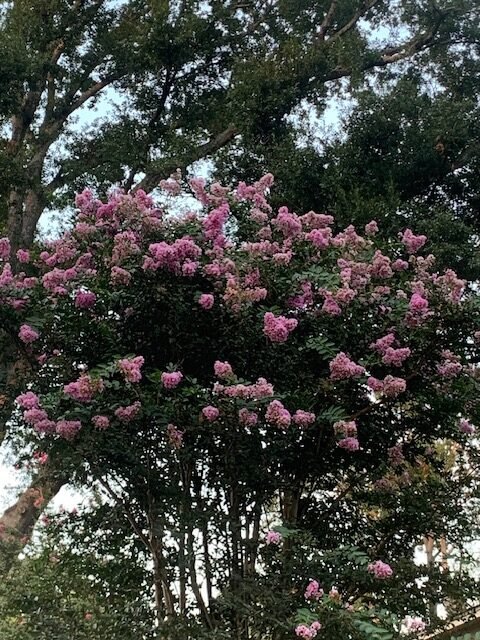
A Plant with Rich History
The Crepe Myrtle’s history is as fascinating as its appearance. Native to parts of Asia, these trees have traveled far and wide, bringing their beauty to gardens all around the world. In the United States, they have a special connection to the South, where they are often seen gracing historic homes, public parks, and quiet streets.
Cultural Significance
In some cultures, Crepe Myrtles are symbols of love and beauty. They’ve inspired art, poetry, and even folklore. For me, knowing that these trees have been admired across different cultures and centuries adds another layer of appreciation. It’s not just a plant; it’s a part of our shared human experience.
Southern Charm
In the Southern United States, Crepe Myrtles are practically a staple. They line boulevards, shade porches, and frame gardens. Growing up in the South, these trees were a constant in my life, their blooming cycles a reliable marker of time passing. They remind me of home, of long, lazy summers, and the comforting hum of cicadas.
Easy to Care For
One significant reason I love Crepe Myrtles is how easy they are to care for. They are the epitome of a hardy plant, able to withstand all sorts of weather conditions while still putting on a spectacular show every year.
Low Maintenance
Crepe Myrtles are not fussy. They thrive in different soil types, are drought-resistant, and are not prone to many diseases. I adore plants that don’t require constant pampering but still reward you with stunning beauty. Knowing that I don’t have to hover over them constantly makes them all the more enjoyable.
Pruning Tips
Even though Crepe Myrtles don’t demand a lot of effort, a little bit of pruning can go a long way. I remember the first time I learned to prune a Crepe Myrtle; it felt almost therapeutic. Removing dead or crossing branches not only keeps the tree healthy but also enhances its natural shape. The best time to prune, as I’ve learned, is during the late winter before new growth starts. It’s a simple task that pays off in dividends when the blooms come in stronger and more vibrant.

Wildlife Friendly
Another reason Crepe Myrtles make me smile is how they attract wildlife. Who doesn’t love a garden teeming with life? These trees are a magnet for bees, butterflies, and birds, turning any garden into a lively, buzzing sanctuary.
Bees and Butterflies
In summer, the blossoms are like an all-you-can-eat buffet for bees and butterflies. I’ve spent countless hours just watching these tiny creatures flit from flower to flower, gathering nectar. There’s something incredibly peaceful about observing nature in action. It feels like being part of a larger ecosystem, one where every creature has its role.
Birds
Once the flowers have faded, the Crepe Myrtle produces small, dark fruits that certain birds find irresistible. I love waking up to the cheerful chirping of birds feasting on the seeds. It’s as if the tree continues to give long after its blossoms have fallen, providing food and shelter for our feathered friends.
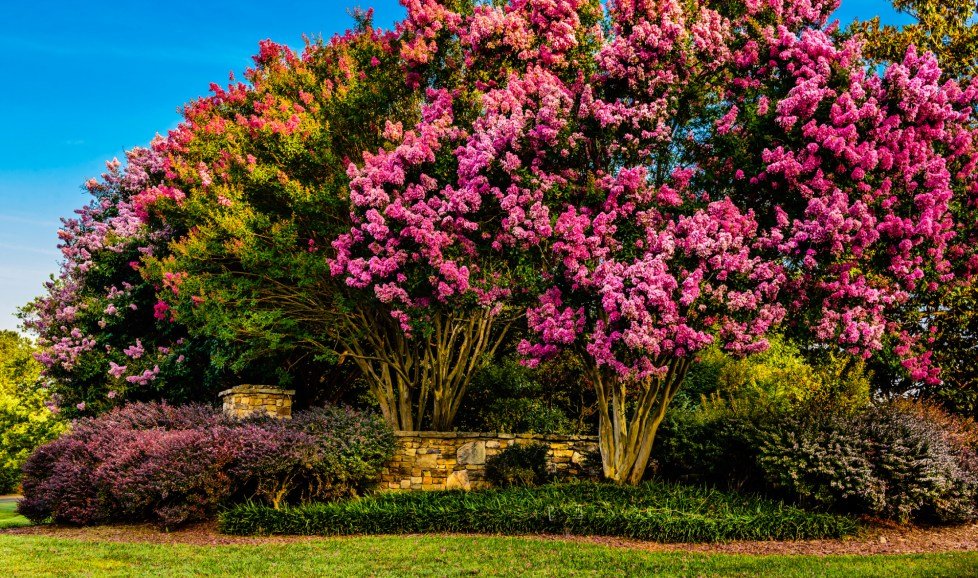
Versatility in Landscapes
One of the most endearing qualities of Crepe Myrtles is their versatility. Whether you have a sprawling backyard or a small urban garden, there’s a Crepe Myrtle variety that will fit perfectly.
Different Sizes
Crepe Myrtles come in various sizes, from dwarf varieties that can be grown in containers to large tree forms that can serve as striking focal points. In my garden, I have a mix of both. The taller ones provide much-needed shade, while the smaller, container-grown types add color and interest to my patio.
Complementing Other Plants
These trees also play well with others. They can be the stars of a mixed border or act as a backdrop for other shrubs and perennials. I find joy in designing garden beds with Crepe Myrtles as anchor plants, surrounded by complementary colors and textures. Their delicate, crinkled blooms contrast beautifully with spiky grasses or soft, flowing perennials.
Environmental Benefits
Crepe Myrtles are not just about aesthetics; they also offer several environmental benefits. In an era where every small effort to support the environment counts, planting and caring for a Crepe Myrtle feels like a step in the right direction.
Erosion Control
The extensive root systems of Crepe Myrtles help in stabilizing soil and preventing erosion. If you have a slope in your garden, planting these trees can help hold the soil in place. I planted one on a slight incline in my yard, and it has done wonders in preventing soil wash during heavy rains.
Improved Air Quality
Like all trees, Crepe Myrtles are powerful air purifiers. They absorb pollutants and release oxygen, making the air around them cleaner and fresher. On hot summer days, standing under the canopy of a Crepe Myrtle feels like an escape to a cooler, cleaner microclimate.
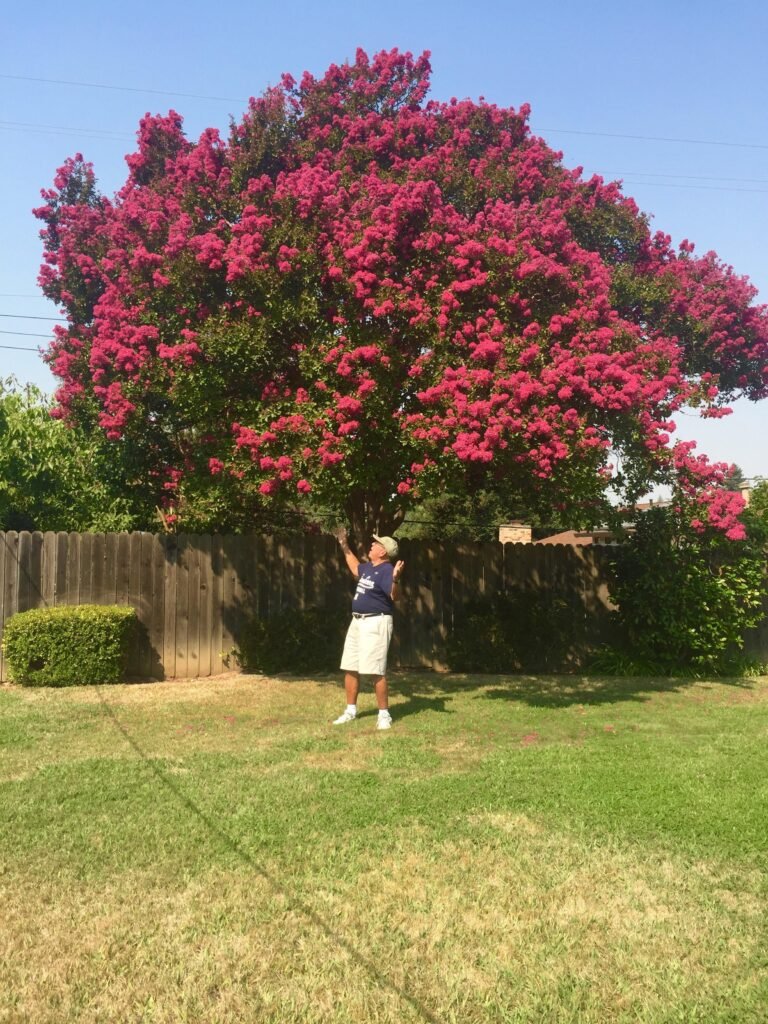
A Palette for Every Gardener
Crepe Myrtles offer a diverse palette that appeals to gardeners of all tastes. Whether you’re after a certain color, size, or growth habit, there’s a Crepe Myrtle that will meet your needs. Here’s a quick guide to some popular varieties:
| Variety Name | Bloom Color | Height | Special Features |
|---|---|---|---|
| Natchez | White | 20-30 feet | Exfoliating bark; mildew-resistant |
| Dynamite | Red | 20 feet | Intense red flowers |
| Sioux | Pink | 15-20 feet | Mildew-resistant, colorful fall foliage |
| Dwarf Purple | Purple | 3-5 feet | Compact, great for containers |
|Looking at this table, I feel like each variety has its own personality, offering something unique to the garden. Whether it’s the striking red flowers of the ‘Dynamite’ or the delicate white of the ‘Natchez,’ each one contributes something special to the landscape.
The Personal Connection
Perhaps the most compelling reason why Crepe Myrtles make me smile is the personal connection I have with them. They remind me of all the places and moments in my life where these trees have stood as silent witnesses.
- Thrives in USDA zones 6-10
- Grows to mature size 96 inches W x 72-144 inches H
- Full sun to partial shade
- Thrives in USDA zones 6-10
- Grows to mature size 96 inches W x 72-144 inches H
- Full sun to partial shade
Childhood Memories
Crepe Myrtles were a staple in my grandparents’ garden. I remember playing underneath their branches, climbing them, and admiring their blooms each summer. These trees were a backdrop to so many happy moments of my childhood. The smell of their blossoms brings back memories of innocence and joy. The Crepe Myrtle really goes a long way in improving your overall mental health!
A Living Legacy
Over the years, I’ve planted Crepe Myrtles in every garden I’ve owned. Each tree is a living legacy, a piece of my history, and a gift I pass down to future generations. Watching them grow and flourish is a reminder of the enduring beauty of nature and the connections we form with the world around us.
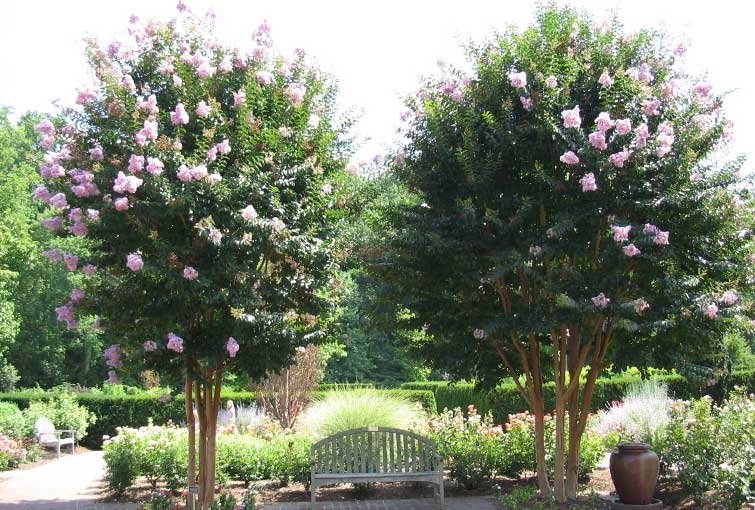
Practical Uses
Aside from their ornamental appeal, Crepe Myrtles have practical uses that are often overlooked. Their wood, for instance, is surprisingly strong and durable.
Wood Uses
While not commonly used for commercial purposes, Crepe Myrtle wood is ideal for crafting small items like walking sticks and tool handles. It’s another way these trees can be honored and utilized beyond their life as garden ornaments. The wood’s hardness is a testament to the tree’s resilience and strength.
Floral Arrangements
The blossoms and branches of Crepe Myrtles also make excellent additions to floral arrangements. I’ve often cut a few stems to bring indoors, where their airy blooms add a touch of elegance to any room. They last surprisingly long in a vase, allowing me to enjoy their beauty even when I’m inside.
Sustainability and Crepe Myrtles
In the realm of sustainable gardening, Crepe Myrtles are a stellar choice. They require minimal water once established and thrive without heavy use of chemicals or fertilizers. For me, knowing that these trees fit well into an eco-friendly garden makes them all the more appealing.
Water-Wise
Crepe Myrtles are drought tolerant once they are established, making them perfect for regions that face water restrictions. While young trees need regular watering, mature Crepe Myrtles can survive on rainfall alone. This characteristic not only conserves water but also reduces the hassle of constant watering.
Natural Pest Control
These trees are relatively pest-free and don’t require harsh chemicals to keep them looking their best. Beneficial insects often handle any minor pest issues, creating a balanced ecosystem in the garden. The less I have to worry about pesticides, the happier I am, knowing my garden is a safe haven for all its inhabitants.
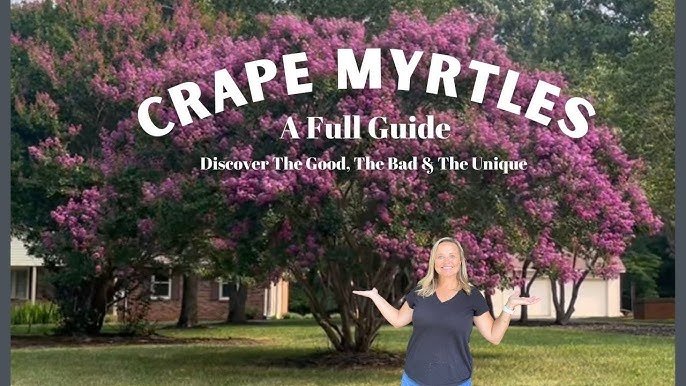
Creating Memories with Crepe Myrtles
Lastly, Crepe Myrtles are more than just beautiful trees. They have the power to create lasting memories and connections between people and their gardens. Planting them becomes an act of hope and anticipation, knowing that each bloom will mark another year of growth and change.
Garden Traditions
In my family, planting a Crepe Myrtle has become a tradition to celebrate new beginnings. We’ve planted them for birthdays, anniversaries, and even as memorials. Each tree stands as a living reminder of those special moments and people who have touched our lives.
Sharing the Joy
Gardening with Crepe Myrtles has also been a way to share joy with others. I’ve given saplings as gifts, helping to spread the beauty and resilience of these trees to friends and family. Watching these trees grow in someone else’s garden is like seeing a piece of my happiness take root and flourish elsewhere.
In Conclusion
Crepe Myrtles are more than just trees to me; they are a source of endless joy and inspiration. Their vibrant blooms, resilience, and ability to create lasting memories make them my favorite garden companions. They’re a symbol of beauty, history, and personal connections that enrich my life in countless ways. I hope that by sharing my love for Crepe Myrtles, I can inspire others to appreciate these remarkable trees and maybe even plant one of their own. After all, a little more beauty in the world can always make us smile.

My name is Michelle Warren, and I’m the founder of Peaceful Gardening. As a 10-year breast cancer survivor, I’ve discovered the profound therapeutic power of gardening. This journey has not only helped me recover but has also become my passion and a source of ongoing peace and joy.
Peaceful Gardening was born from my desire to share the healing benefits of gardening with others. Whether you’re facing health challenges, dealing with stress, or simply looking to connect more deeply with nature, this space is for you.
Over the past decade, I’ve cultivated not just plants, but a deep understanding of how gardening can positively impact mental health. I’ve worked with local community gardens, led workshops on mindful gardening practices, and collaborated with mental health professionals to develop gardening-based stress reduction programs.
Peaceful Gardening was born from my desire to share the healing benefits of gardening with others. Whether you’re facing health challenges, dealing with stress, or simply looking to connect more deeply with nature, this space is for you.
Here, you’ll find evidence-based advice on using gardening as a tool for mindfulness, stress relief, and emotional healing. I share personal stories, practical tips, and scientifically-backed information on how to create your own therapeutic garden space, no matter the size of your yard or balcony.
My mission is to help you discover the joy, peace, and healing that comes from nurturing plants and connecting with nature. Join me in exploring how the simple act of tending to a garden can transform your mental and emotional wellbeing.
Welcome to Peaceful Gardening – let’s grow together towards better mental health!”


